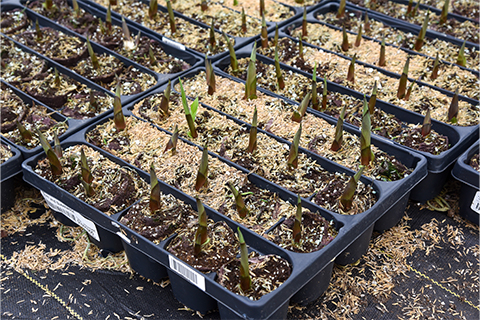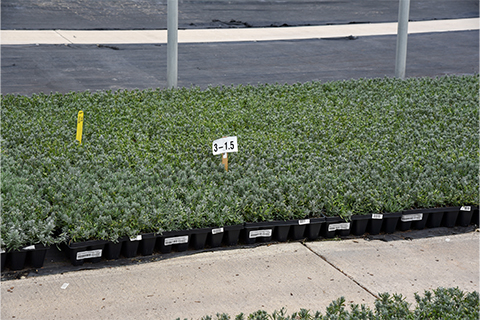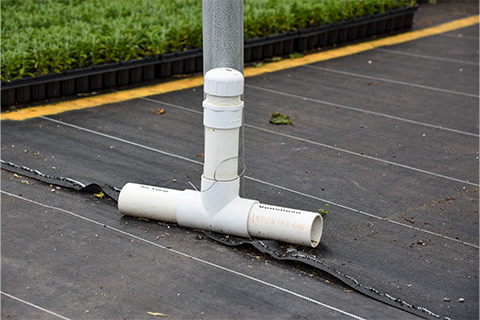7/31/2025
Perennials Section: Vernalizing Perennials: A Grower's Guide to Successful Overwintering
Drew Koschmann

Over the years, I’ve learned that producing top-quality perennials for landscape and retail performance involves more than planting and waiting. You need a strong understanding of plant physiology, a commitment to environmental management and a solid overwintering strategy.
Hostas in production emerging after winter.
At Walters Gardens in southwest Michigan, we face the challenges of a highly variable winter climate, with daytime highs occasionally in the 50sF (10sC) and nighttime lows plunging into the teens. Our December through early March temperatures generally hover between the mid-30s and low-20sF (single-digits to low-teens C), making precise preparation crucial for minimizing winter losses. To help ensure perennial success throughout the cold season, we’ve spent decades honing the following best practices.
Focus on scheduling
Scheduling is the backbone of any successful perennial program. When plants remain in containers too long, they may develop oversized canopies and become prone to disease, particularly Botrytis. Conversely, planting too late often leads to poor root and crown development, which in turn increases the risk of overwintering losses.
The key is to understand the specific vernalization requirements for each genus. Vernalization—the cold period many perennials require to trigger flowering—varies widely across species. Our in-house trials department works closely with our research and development team to identify the optimal cold period for each new variety. For instance:
- Leucanthemum, veronica and some Lavandula varieties benefit from at least eight weeks of cold treatment.
- Dianthus typically needs around six weeks for consistent flowering.
- Campanula glomerata may require 10 to 15 weeks to fully vernalize.
Using this data, we set our production goals accordingly. For varieties that require vernalization, we aim to finish plugs by late October and place them into environments maintained at about 36F (2C). This setup is cold enough to initiate vernalization, but warm enough to keep irrigation systems from freezing.
Stay vigilant about climate control
Transitioning plugs from warm to cool environments requires you to closely monitor and fine-tune climate control. At Walters Gardens, we face several common challenges including:
- Condensation drips that over-saturate soil and damage root systems in species like Lavandula, heuchera, agastache and dianthus.
- Gaps in greenhouse film that introduce cold drafts and uneven drying.
- Poor airflow, which exacerbates humidity and fosters disease—especially in crops like primula, heuchera and monarda.
 To counteract these issues, we use anti-condensate greenhouse films and install horizontal airflow (HAF) fans to maintain uniform air distribution and reduce condensation. Our Priva systems are programmed to purge air whenever humidity exceeds 80%.
To counteract these issues, we use anti-condensate greenhouse films and install horizontal airflow (HAF) fans to maintain uniform air distribution and reduce condensation. Our Priva systems are programmed to purge air whenever humidity exceeds 80%.
Overwintering perennials involves more than just enduring the cold. Have a plan to monitor moisture to avoid over- or under-watering.
We also use advanced Priva systems—including Maximizers, Compass and Connext models—to maintain stable greenhouse climates. Our growing team typically sets a 4 to 6F differential between heating and venting temperatures—heat at 36F (2C), vent at 42F (5C). This helps stabilize temperature fluctuations, reduce disease pressure and manage humidity.
For growers without automated systems, passive cooling—such as adjusting doors or vents manually—can help, though it requires vigilance.
Prepare plugs for spring success
Once plugs are placed into cold storage by early October, nutrient management becomes essential. As days grow shorter and cooler, high salt levels can lead to root burn. At Walters Gardens, we proactively lower soluble salts to around 1.0 (measured via the pour-through method). Closer to spring, we gradually increase EC levels to 1.5 to 2.0 to support new growth.
Get your trimming timing right
Trimming back perennials can be beneficial, but only when you do it at the right time. Plants overwintered in protected spaces like cold frames may retain their foliage longer than those in open fields, so timing should account for energy transfer from leaves to roots.
Here are some general guidelines:
- Trim hostas in the nursery or field in mid-to-late November. In greenhouses, you may need to wait until late December to trim.
- Late winter is the best time to cut back brunnera, delphinium, echinacea and non-evergreen ferns.
- Evergreen varieties like hellebores, dianthus and heuchera are lightly trimmed or not trimmed at all. Instead, we manage their growth through proper airflow, scheduling and occasional use of PGRs.
-
Properly Manage Moisture
To standardize moisture management across our growing team, we use a 1 to 5 scale to assess moisture levels (5 = saturated, 1 = dry and wilting), so:
- In warmer greenhouses, plants like echinacea and heuchera follow a 4 to 2 watering scale.
- In colder structures, the range shifts to 3 to 1.5.
 Team communication is vital in this approach. Use signage and review moisture targets regularly to avoid under- or over-watering. In unheated hoophouses, check moisture often. A helpful trick I learned from a previous employer involved alternating watering between the edges and center aisle every few days to even out soil moisture. We also use foam rolls on the outside of houses to minimize airflow and retain heat—an inexpensive yet effective insulation tactic.
Team communication is vital in this approach. Use signage and review moisture targets regularly to avoid under- or over-watering. In unheated hoophouses, check moisture often. A helpful trick I learned from a previous employer involved alternating watering between the edges and center aisle every few days to even out soil moisture. We also use foam rolls on the outside of houses to minimize airflow and retain heat—an inexpensive yet effective insulation tactic.
Mice can cause serious damage in perennial crops. Be sure to use bait stations throughout the year.
Successfully overwintering perennials involves more than just enduring the cold—it’s about proactive planning, detailed scheduling and environmental awareness. By understanding each crop’s vernalization needs and maintaining ideal conditions throughout the winter, you can minimize losses and boost plant quality in spring.
Don’t Overlook the Details
These additional overwintering considerations can make a big difference in overall success.
- Rodent control: Use bait stations year-round. Mice can cause serious damage, particularly to astilbes, irises and ornamental grasses.
- Weed and moss management: Apply ¼ to ½ in. of rice hulls on pot surfaces to prevent the growth of winter weeds like chickweed, bittercress and bluegrass. We also spot-treat liverwort with 70% alcohol.
- Disease scouting: Botrytis and other fungal diseases thrive in cold, humid conditions. We apply fungicides every two weeks during winter and rotate FRAC codes to prevent resistance. Common active ingredients include chlorothalonil, iprodione, fludioxonil and fenhexamid—with calcium chloride often added for nutrient support.
- Late frosts: In early spring, when removing greenhouse coverings, be alert for frost forecasts. Instead of re-covering with plastic, use lightweight frost blankets to protect sensitive foliage. GT
Drew Koschmann is Director of Greenhouse for Walters Gardens.